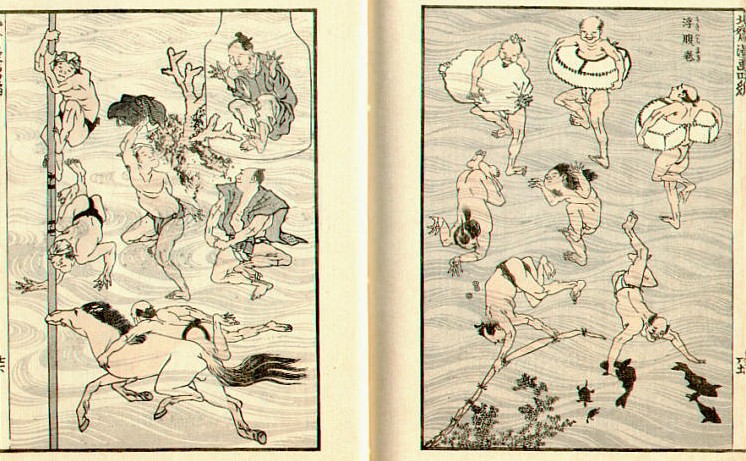Much of the art was originated by the ukiyo-e school of art, which offered a transition period of Impressionism which would eventually morph into the decorative qualities and artistry of Japonisme.
Characteristics
The prominent characteristics of the paintings of those Impressionist artists influenced by Japanese art include a more elongated pictorial forms and an asymmetrical composition. Both of these complex painting styles have been illustrated by Edgar Degas. The clever way in which his artworks such as Dancers in the Rehearsal Room with a Double Bass (1885) and The Dance Class and The Star (1884) experiment with perspective twists and spins the perspective of the viewer over the artwork and once again, furthering the ideas of Impressionism to the point of extending the scene into the canvas.
| "The Star" by Edgar Degas, painted in 1884. |
The image above distorts and twists the view of the audience as previously described. This is due to the influence of Japan and the way it changed and developed styles that Degas had already adopted, changing the perspective and the more abstract quality of the painting as the view feels a greater sense of movement. The root of such inspiration for this style can be seen in some of the below examples of design in Japonisme.
Decorative Motif and Ornamentation
One of the most design based art movements we have seen as early as the 19th Century, Japonisme takes a particular focus on decorative motif, often looking at nature and aesthetics popular in Japan, giving Europe an insight into the art that had flooded it's shores from across the world.
 |
| "Egret and Willow" by Suzuki Kiitsu, a two fold screen made of silk on cotton. |
| "La Japonaise" as painted by Claude Monet by Oil on Canvas (1876). |
Techniques of printmaking really took off in this period as a direct result of the imports of art from Japan, beginning with it the experimentation in Europe with graphic imagery and stylization for print. It was painters such as Claude Monet and James Abbot McNeil Whistler that first looked at imitating this process for their own designs. Many of the influences came from the Japanese artist Ando Hiroshige (1797 - 1858). Vincent Van Gogh himself explored the imitation of woodblock print design on canvas with oil paints, adopting the style of Japanese art but maintaining the format of Impressionism and traditional European art.
| (Left) Ando Hiroshige's "Plum Estate, Kameido" from "One Hundred Famous Views of Edo" 1857, made by Woodblock Print inspired (Right) Vincent Van Gogh's "The Blooming Plum Tree" Oil on Canvas, 1887. |
 |
| "The Great Wave Off Kanagawa" by Katsushika Hokusai, Woodblock Print, from "Thirty Six Views of Mount Fuji" (1831) |
The Great Wave Off Kanagawa is a woodblock print that is still of prominence today, with the most long lasting influence and commercial use in the 21st Century, emphasising the popularity of this graphics based stylized image, featuring the flowing shapes of Japonisme along with blocks of colour and heavy use of line.
The Origins of Manga
The origins of Japanese illustrative art began to take shape from the 1780's, spreading through Europe in the late 19th Century to rise to prominence and further the field of animation and illustrative art. The images are often violent, depicting Japanese actors, heroes and sports and filled with movement, this began with a series of many small drawings and later influencing more colour prints.
 |
| "Hokusai Manga" or "Sketches by Hokusai" |
From such Japanese works as the illustrative art, Hokusai's Manga and woodblock prints, Toulouse-Lautrec developed a technique that encompassed these idea for a series of inspired European prints. These were often made for events such as theatres and bars, places Lautrec was in collaboration with. These put an emphasis on the stylized prints of line and block colours for a simple and bold print, using mainly primary and secondary colours to promote the Moulin Rouge and other establishments. One such example is The Moulin Rouge Poster which involves a different take on his own work and the introduction of typography is this print-based-media, this developed the way in which we began to communicate through art and advertise before Art Nouveau.
| Moulin Rouge Posters by Toulouse-Lautrec. |
In conclusion to the Japonisme period, it is becoming to become clear that with globalization and the opening up of borders and trading between the Western world and other cultures, we see a dilution of European culture, particularly in regards to the arts. It proves that many of the techniques we still use in the 21st Century are derivative from the inventions of continents across the world, from the Middle East to Asia, we are constantly influence by new themes of art and design. This is a period in which design became to be influential on furniture and product design. The influence of the woodblock print, silks and decorative motifs resonated the most with European artists such as Vincent Van Gogh and Claude Monet.


0 comments:
Post a Comment